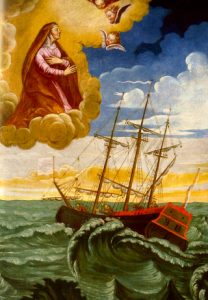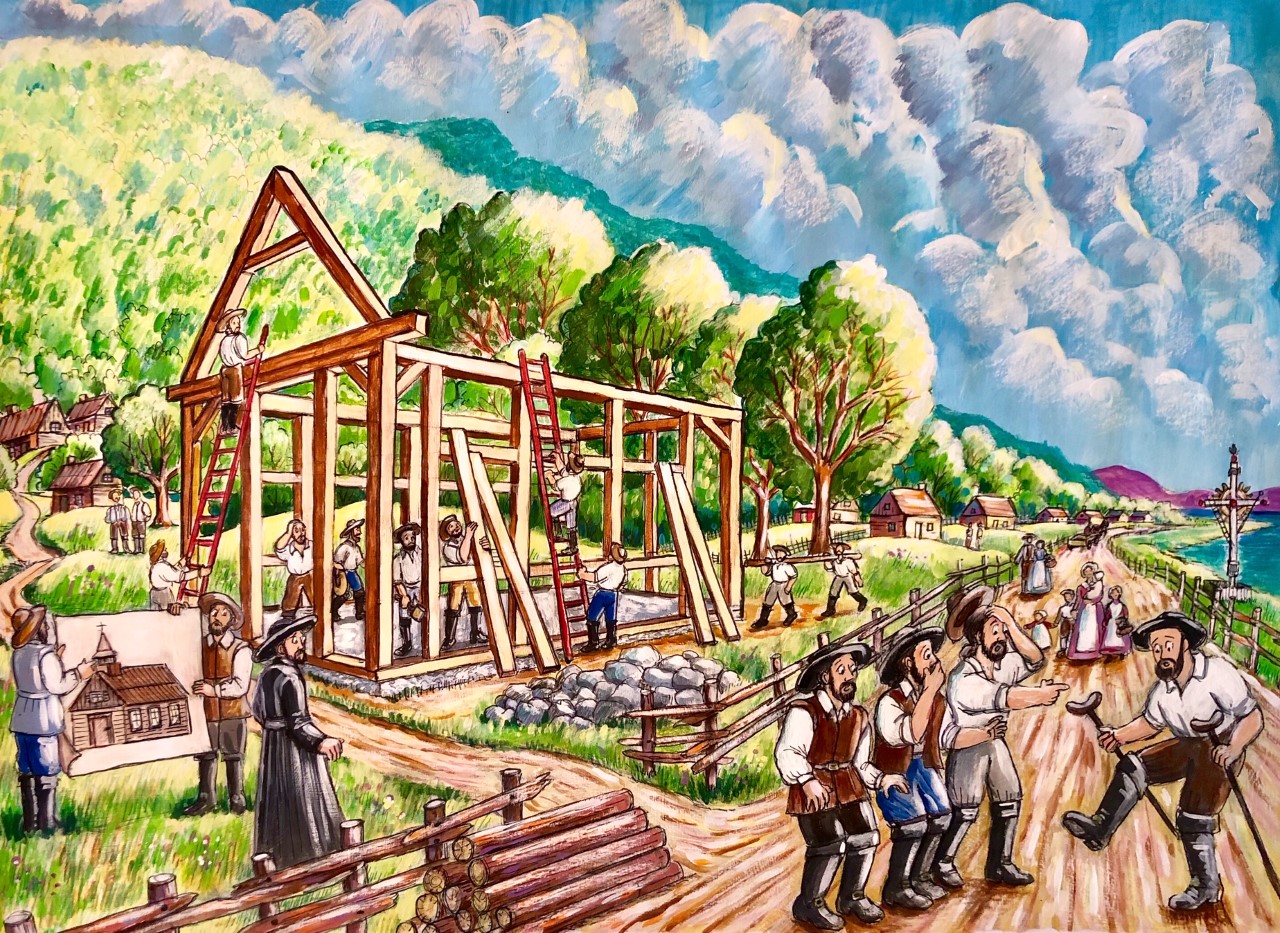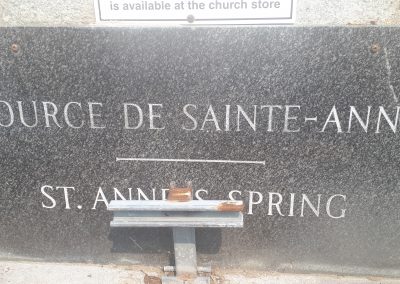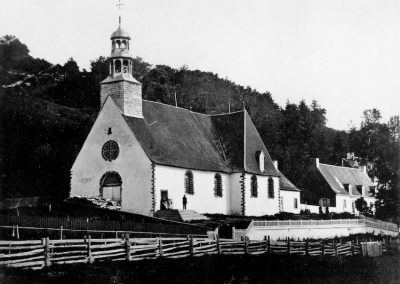Le sanctuaire de Sainte-Anne-de-Beaupré
La première église à Sainte Anne au Canada:
L’on serait porter à croire que la toute première église dédiée à Sainte Anne au Canada ne fut autre que la chapelle qui deviendra le sanctuaire à Beaupré, au Québec. Il semblerait, cependant, qu’une autre église lui aurait précédée et qui aurait été construire par Charles Daniel en 1629 dans l’actuelle Nouvelle-Écosse, sur l’île du Cap-Breton. Tout a commencé lorsque, en 1629, le capitaine Charles Daniel entendit dire que la couronne britannique complotait de conquérir la Nouvelle-France. Il organisa alorsune flotte en vue d’aller à la rescousse de Samuel de Champlain. Il fut cependant trop tard, car les Frères Kirke avaient déjà conquis Québec avant son arrivée. Daniel décida donc de s’installer sur l’île du Cap-Breton et d’y bâtir le fort Sainte-Anne, situé dans l’actuelle Englishtown. Le petit fort fut rapidement muni d’une chapelle que l’on dédia à la Bonne Sainte Anne. Quarante personnes et deux pères jésuites y demeuraient. D’autres Français arrivèrent plus tard.
« En 1632, quand Champlain revint dans sa colonie après le traité de Saint-Germain-en-Laye qui remettait le Canada à la France, il arrêta ses navires à la chapelle du Cap-Breton. Entouré de son équipage, l’âme débordante d’actions de grâces, il remercia la grande Sainte d’avoir tenu si fermement la clef du pays pendant les trois sombres années de la domination [anglo-protestante] ». (c.f. La Bonne Sainte Anne, page 19). « La chapelle de Sainte-Anne du Cap Breton devint un foyer ardent d’où les lumières jaillissantes de la foi se répandaient dans les régions environnantes » (c.f. La Bonne Sainte Anne, page 21)
 L’église de Sainte-Anne-de-Beaupré, deuxième église dédiée à la patronne des Bretons:
L’église de Sainte-Anne-de-Beaupré, deuxième église dédiée à la patronne des Bretons:Quelques décennies plus tard, soit dans les années 1650, des « marins bretons remontent le Saint-Laurent. Une tempête s’élève… Des vagues en fureur se jouent des efforts des marins et les poussent sur les rochers. Déjà l’eau envahit la barque de son écume blanche… elle va couler… Quand, soudain, ces marins se souviennent que jamais un Breton n’invoque sainte Anne sans qu’elle réponde ; confiants, ils tombent à genoux en lui jetant ce cri : Bonne sainte Anne, sauvez-nous! Ils s’engagent par vœu à construire une chapelle à l’endroit où elle conduirait sûrement leur barque. Puis la mer se calme bientôt ; la barque accoste heureusement au rivage de Beaupré, et quelques années plus tard, une petite chapelle s’élève par le soin et la reconnaissance des matelots » (c.f. La Bonne Sainte Anne au Canada et à Beaupré, page 40). Le terrain appartenait à monsieur Étienne Lessard, navigateur de Beaupré, qui offrit généreusement une terre de deux arpents de front sur une lieue et demie de profondeur.
Le premier miracle signalé sur le site eut lieu pendant la construction même de la première chapelle en 1658. Un infirme du nom de Louis Guimond, qui souffrait de rhumatisme, se traînait péniblement sur le chantier ; « plein de confiance, il déposa trois petites pierres dans les fondations ; une vie soudaine et nouvelle coule dans ses membres à demi paralysés ; il est guéri » (c.f. La Bonne Sainte Anne au Canada et à Beaupré, page 47). Cela fut suivit d’autres témoignages de personnes guéries et le futur sanctuaire gagna rapidement en popularité.
La chapelle est déménagée:
La première chapelle de Beaupré qui fut bâtie en 1658 par les soins de l’abbé de Queylus, Vicaire Général de Québec, avait été construite trop près du fleuve. Elle fut rapidement endommagée par les eaux de la marée haute. En 1661, on dut la transporter au bord du grand côteau. On ne garda que la charpente pour construire ce qui devait devenir la première église de Beaupré (la précédente n’étant qu’une chapelle, d’autant plus qu’elle n’a jamais servi pour le culte divin). Le Gouverneur de la Nouvelle-France (peut-être Jean de Lauzon) eut l’honneur de poser la première pierre des fondations.
La nouvelle église ne cessa point de gagner en popularité. Les miracles se faisaient de plus en plus nombreux, selon les dires de Sainte Marie de l’Incarnation. Celle-ci écrivit une lettre à son fils, le 30 septembre 1665 : « À sept lieues d’ici, il y a un bourg appelé le Petit-Cap, où il y a une église de sainte Anne dans laquelle Notre-Seigneur fait de grandes merveilles en faveur de cette sainte mère de la très sainte Vierge. On y voit marcher les paralytiques, les aveugles recevoir la vue, et les malades de quelque maladie que ce soit recouvrer la santé. »

Qui est Louis Guimond:
Né dans la première moitié du XVIIe siècle, Louis Guimond est originaire de la paroisse Saint-Evroult de Champs (Orne, France). Toutefois les registres paroissiaux de cette période ayant disparu dans cette paroisse , son lieu de naissance n’est pas certain. Il est engagé le 18 février 1647 par Nicolas Juchereau , sieur de Saint-Denis pour Jean Juchereau, sieur de More comme manœuvre pour une durée de 6 ans moyennant 40 livres tournois par an. Les traversées aller et retour seront payées. Il reçoit une paire de souliers et un habit de serge de laine.
Louis Guimond pourrait être arrivé à Québec le 6 août 1647 à bord du vaisseau « La Marguerite » parti de La Rochelle deux mois plus tôt. Il fut guéri miraculeusement d’une infirmité en venant poser « trois petites pierres dans les fondations » de la chapelle dite « es matelots » à Sainte-Anne-de-Beaupré. La nouvelle de la guérison dûment attestée par l’abbé Thomas Morel et authentifiée par Monseigneur François de Laval, se répand et Sainte-Anne du Petit-Cap, qui deviendra la basilique Sainte-Anne-de-Beaupré, devient un populaire lieu de pèlerinage.
Il s’établit dans cette paroisse avec Jeanne Bitouset, une parisienne, épousée le 11 février 1653 à Québec. Il y vécut jusqu’au drame du 18 juin 1661, date à laquelle il est capturé par les Agniers (Mohawks), les plus belliqueux de la nation iroquoise, qui l’amènent sur leur territoire situé au delà du lac Champlain, dans la région d’Albany.
Sous la signature du père Jérôme Lalement, une lettre écrite sur une escorce de bouleau par François Hertel, âgé de 19 ans, captif chez les Agnieronnons, et envoyée à sa mère puis au père Simon Le Moyne, nous donne la preuve de son martyre, début juillet 1661. « Il a esté assommé de coups de bastons et de verges de fer; on lui a tant donnés qu’il est mort sous les coups. Mais cependant, il ne faisait que prier Dieu, tellement que les Iroquois, enragés de le voir remuer les lèvres pour prier, lui coupèrent toutes les lèvres hautes et basses. Que cela est horrible à voir! et néanmoins, il ne laissait pas de prier; ce qui dépita tellement les Iroquois qu’ils lui arrachèrent le coeur de la poitrine, encore tout vivant, et lui jetèrent au visage. »
Sainte Anne, patronne du Québec:
En 1876, l’épiscopat demande au Saint-Siège de proclamer saint Anne patronne de la province de Québec, on lit la note suivante dans le mandement de l’archevêque de Québec : « sans préjudice, toutefois, au titre que possède depuis 1624 saint Joseph, époux de la Bienheureuse Vierge Marie, comme patron du Canada tout entier ». Cette demande fut accordée.
Le sanctuaire de Sainte-Anne de Beaurpé se trouve au 10018 avenue Royale, Sainte-Anne-de-Beaupré, Québec.
Sources:
-BÉLANGER, Georges, La Bonne Sainte Anne au Canada et à Beaupré.
-http://www.perche-quebec.com/files/perche/individus/guimond-louis.htm







